PM's focus on central Asia outlines India's great game of influence
The Prime Minister’s focus on central Asia proves that India is very much in the Great Game 2.0.
Central Asia is intrinsically linked to subcontinental history but has been almost completely isolated from modern India. For the first time in decades there are clear signs of India being able to bridge the gaps that have made the nation a marginal player in this region. The first is India’s investment in the Chabahar port of Iran, a piece of concrete evidence that the long-awaited North-South corridor will at last become a reality. It is hard to exaggerate how the lack of a land route to Central Asia has made economic relations between India and Central Asia, and this would include Afghanistan, almost impossible. This is particularly true when it comes to trade with the mineral-rich ‘Stans’ as bulk commodities like oil and coal cannot be sent by airplane. The second development is India’s expected membership in the Shanghai Cooperation Organisation (SCO), the prime security arrangement in the region. Prime Minister Narendra Modi’s attendance at the SCO will be the first by India at the highest level and will help kick off a membership process that should see the country and Pakistan become full-fledged members by 2016. This will provide the multilateral complement to the bilateral defence relations that Mr Modi will seek to revive with many Central Asian nations.

Central Asia is an example of a tier-two region as far as Indian strategic interests are concerned. The region is large, but with less than 60 million people, and its mineral resource available from elsewhere, New Delhi has rightly expended minimal diplomatic capital on Central Asia. China and Russia are the region’s major external players in such a dominant manner that it would be pointless to compete. But circumstances are changing. As mentioned, connectivity is now more feasible. With West Asia entering a renewed period of instability, a growing Indian economy’s dependence on Persian Gulf oil and gas looks dangerous. Central Asia is a possible alternative. The return of Islamicist terror also gives the nations a security convergence. However, India’s immediate strategic benefit may be in helping strengthen a sense of isolation in Pakistan and reminding China that New Delhi is not completely out of the 21st century Great Game.
Mr Modi receives some criticism for his visits to smaller, less-known countries. This is misplaced. Power and resources are diffusing across the globe and it is no longer enough to focus all of a country’s diplomacy on a few countries.
Second-string nations are now of importance. In a world in flux it makes sense to hedge one’s bets, make friends in all four corners of the world and wave the flag everywhere. Central Asia makes more sense than most. There are more than the normal straws in the wind, indicating an opening that has not been around for at least two decades.



